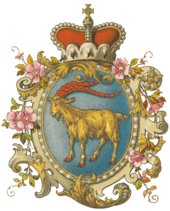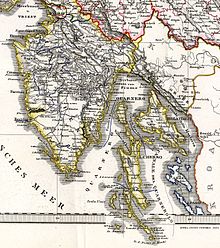Margraviate of Istria
The Margraviate of Istria ( Italian Marchesato d'Istria , Croatian Markgrofovija Istra , Slovenian Mejna grofija Istra ) was a monarchy on the Adriatic , which existed on the territory of the Istrian peninsula .
The land, which came under the Habsburg monarchy in 1797 , was established as an independent crown land in 1849 and remained this until its dissolution in 1918 in the Austrian Empire, constituted in 1804 and from 1867 in the Real Union of Austria-Hungary , in Istria to Cisleithania , the kingdoms represented in the Imperial Council and Countries that belonged.
After the end of the First World War , the country was annexed by the Kingdom of Italy .
The capital of the margraviate was today's Croatian Parenzo ( Croat . Poreč ).
history
Emergence
The House of Habsburg had ruled the inner parts of Istria since 1364. The coastal areas remained under the rule of the Republic of Venice . In the course of the coalition wars of revolutionary France against the European monarchies, Venice was occupied by Napoleon Bonaparte in 1797 and the former aristocratic republic was divided between France and the Habsburg monarchy in the Peace of Campo Formio . In doing so, Austria gained control of the entire peninsula for the first time. The Habsburgs ruled until 1918, with the exception of the brief French occupation 1805–1813.
Austrian crown land
After the collapse of the French Empire in 1814, Istria became part of an Austrian crown land in the Kingdom of Illyria . After the revolution of 1848/1849 in the Austrian Empire , it was dissolved again and the Margraviate of Istria was founded in March 1849. The Emperor of Austria was automatically at the same time Margrave of Istria; until 1916 this was Franz Joseph I , then until 1918 Karl I.
With the February patent of 1861, in which Istria was granted an elected state parliament and an autonomous state committee formed from it, Istria, as a constitutional monarchy , also received extensive internal autonomy.
The monarch himself was represented in the crown land of Istria by the imperial governor in Trieste , who was also governor for this city and for the county of Gorizia . The governor was in close contact with the imperial government in Vienna for Cisleithanien and their kk ministries, most recently with the Lammasch ministry .
With the Austro-Hungarian Compromise of 1867, with the federal dual monarchy of Austria-Hungary was, remained Istria independent crown land of the so-called Austrian half , but was from 1868 together with the two other crown lands Empire Direct Trieste and the princely county of Gorizia and Gradisca by an Imperial and Royal Head of State administered from Trieste (see Austrian Coastal Land ).
At the beginning of 1861, Istria sent two members to the Reichsrat , the cisleithan parliament in Vienna, and finally after the Reichsrat election from 1911 to 1918 six Croatian and Italian mandatars from a total of 516 members (see list of members of the Austrian House of Representatives (12th legislative period) ).
The economic growth of Austria-Hungary led to a certain upswing due to the expansion of trade in Istria, especially in coastal cities such as the provincial capital Parenzo or Poreč or Pola or Pula , where the most important naval port of the Austro-Hungarian Navy was located. The rapid growth soon led to the immigration of Germans and Magyars .
The Croatian population in particular now placed increasing importance on their mother tongue. Although the Croatians and Slovenes , especially the rural population, were not politically organized for a long time, they increasingly played an important role in the culture and later also in the education of the country. There were numerous new Croatian newspapers, nationalist associations and cultural centers. The first opened in Kastav in 1886 .
First World War and dissolution
At first , Istria was spared from the First World War . After Italy declared war on Austria-Hungary on May 23, 1915, the crown land of Istria also became a theater of war on the Italian front . On the basis of real or alleged sympathies, the joint Austro-Hungarian army deported around 60,000 Yugoslav- oriented Croats and Slovenes and supporters of the Italia irredenta idea to internment camps in the Austrian hereditary lands and the countries of the Bohemian Crown . Many died of disease and starvation . A military government was established in Istria . The civilian population also suffered from food shortages due to the presence of large numbers of soldiers on Istrian soil.
Most of the Croatians and Slovenes in the country remained loyal to the monarchy until the end of the war. It was not until 1917, when the Austrian Imperial Council was convened again on May 30th after more than three years, that the Istrian MPs, like those of other nationalities, made their commitments to a desired national state.
With the dissolution of Austria-Hungary on October 31, 1918, the Istrian provincial government resigned and transferred power to local people's committees of the Italian minority in western Istria. In mixed regions such as Pula, clashes broke out between Italians and Croats and Slovenes who wanted to join the newly formed Kingdom of Serbs, Croats and Slovenes . After the armistice of Villa Giusti on November 3, 1918, troops of the Royal Italian Army occupied Istria on November 4. The Italians eliminated all remaining state institutions, and Istria was annexed to the kingdom. The annexation was confirmed by the Rapallo Border Treaty in November 1920. Many Croatians and Slovenes were expelled or assimilated through a ruthless Italianization policy . It was not until 1945 that Croatians and Slovenes achieved membership of Yugoslavia.
politics
The political system or life in Istria was initially determined primarily by the Italian minority.
Due to the census suffrage , which was designed for the elector's possession, the Italians were initially represented in the majority in the Istrian parliament . The Croatians and Slovenes were also able to move into the state parliament from 1878 with the establishment of mixed parties. A new, younger generation of politicians in Istria founded the Social Democratic Party of Istria in 1907 after universal and equal male suffrage was introduced for the Imperial Council , but not the regional parliaments.
administration
Istria was divided into seven districts and 16 judicial districts.
Margraves
There were two margraves in total. Both came from the House of Habsburg-Lothringen . First Franz Joseph I (1848–1916) ruled , then Charles I (1916–1918). The two rulers were also the only two monarchs in Austria-Hungary.
Demographics
According to the census of 1846, 228,035 inhabitants lived in the margraviate, 230,324 inhabitants in 1857 and 386,463 inhabitants in 1910. About 99.6% of them were Catholic . The rest was split between Jews and Protestants .
An old Italian minority lived in Istria until the end of the Second World War . After the unification of Italy , there was an increase in immigration from Italy. The proportion of Italians grew - from 32% in 1846 to 40% in 1900. With the beginning and growth of tourism, an increasing number of Germans came to the country. The German population grew by 18% from 1846 to 1910. That of the Slovenes by 7.4% and the Croatians by 3.9%. The following table shows the growth and the proportion of the respective population groups in the crown land:
| 1846 | 1880 | 1890 | 1900 | 1910 | |
|---|---|---|---|---|---|
| Croatians | 54.0% (134,455) | 43.4% (121,732) | 44.3% (140,713) | 42.6% (143,057) | 43.5% (168,184) |
| Italian | 32.5% (60,040) | 39.7% (114,291) | 37.2% (118,027) | 40.5% (136,191) | 38.1% (147,417) |
| Slovenes | 12.9% (31,995) | 14.4% (43,004) | 13.9% (44,418) | 14.2% (47,717) | 14.3% (55,134) |
| German | 0% (0) | 1.7% (4,779) | 1.9% (5,904) | 2.1% (7,076) | 3.3% (12,735) |
| total | 228.035 | 284.154 | 317.610 | 345.050 | 386.463 |
economy
Despite the industrialization of most of Austria-Hungary, Istria remained an agricultural country . The backbone of the economy consisted of olive and grape growing . About 80% of the oil and wine was exported. The wine was 1882 183.280 in hectoliters . On islands in the Kvarner Bay , the inhabitants lived mainly from fishing . The only industry worth mentioning remained shipbuilding , especially the shipbuilding industry for the Austro-Hungarian Navy. There were also brown coal deposits with mines in Labin and Buzet .
Transport in Istria was mainly determined by rail and sea traffic .
See also
literature
historical monographs:
- Ignatz de Luca: Istreich. In: Geographisches Handbuch von dem Oestreichischen Staats. 2. Volume The countries in the Austrian district. Verlag Johannes Paul Krauss, Vienna 1790, pp. 335–502 ( Google eBook, full view ).
Web links
Individual evidence
- ↑ Special locations repertory of the Austrian federal states I-XII, Vienna, 1915–1919 ( Memento of the original dated May 29, 2013 in the Internet Archive ) Info: The archive link was inserted automatically and has not yet been checked. Please check the original and archive link according to the instructions and then remove this notice.




